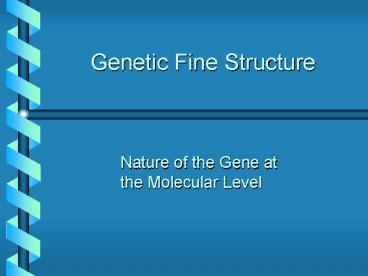Genetic Fine Structure - PowerPoint PPT Presentation
1 / 27
Title:
Genetic Fine Structure
Description:
Genetic Fine Structure. Nature of the Gene at the Molecular Level. Bead Theory ... Bead Theory. The gene is the fundamental unit of. 2. Change ... – PowerPoint PPT presentation
Number of Views:1126
Avg rating:3.0/5.0
Title: Genetic Fine Structure
1
Genetic Fine Structure
- Nature of the Gene at the Molecular Level
2
Bead Theory
- The gene is the fundamental unit of
- Structure
- The gene is indivisible by crossing over.
- Crossing over occurs only between genes.
3
Bead Theory
- The gene is the fundamental unit of
- 2. Change
- The whole gene must change from one allelic
form to another, there are no smaller components
within gene can change by mutation.
4
Bead Theory
- The gene is the fundamental unit of
- 3. Function
- The gene functions as a unit, parts of a gene
cannot function on their own.
5
Revised Bead Theory
- The nucleotide pair is the fundamental unit of
- Structure
- Change
- The gene is the fundamental unit of
- 3. Function
6
How Can the Expression of a Gene by Altered By
- 1. Intragenic recombination?
- 2. Mutation?
- 3. Complementation?
7
Intragenic Recombination
- Recombination within a gene is shown by
recombination between two mutants to give a wild
type (non-mutant) form of the gene.
8
Application Deletion Mapping
- Deletions prevent recombination.
- If no wild type recombinants can be produced in a
cross between two deletion mutants, the deletions
are overlapping. - Regions of a gene can be defined by deletion
mutations, and point mutations can be located
within those regions.
9
Application Deletion Mapping
Non-overlapping deletions
Overlapping deletions
Unable to achieve recombination to restore wild
type
10
Application Deletion Mapping
Deletion and Point Mutation do not overlap
Deletion and Point Mutation overlap
Unable to achieve recombination to restore wild
type
11
Deletion mapping of the rII regionof
Bacteriophage T4.
12
Application Deletion Mapping
Problem 1, page 3-4
Deletion Mutants
Deletion Mutants
Deletion Mutants
Site-Specific Mutations
13
Application Deletion Mapping
Solution Problem 1, page 3-4
14
How Can the Expression of a Gene by Altered By
- Intragenic recombination?
- Recombination between two mutant forms gives
a wild type version of the gene --- a new
genotype is produced.
15
Mutation
- Types of mutations
- 1. Silent
- 2. Synonymous (Neutral)
- 3. Missense
- 4. Nonsense
- 5. Frameshift
16
Mutations
Change in a nucleotide can lead to change in
amino acid found in the protein.
17
How Can the Expression of a Gene by Altered By
- 2. Mutation?
- Change in DNA triplet can alter amino acid
sequence of protein.
18
Complementation
- Production of the wild type phenotype when
two different mutations are combined in a diploid
or heterokaryon.
19
Application Complementation Tests
- If a wild type phenotype cannot be produced in a
cross between two mutants, the mutations are in
the same gene (cistron). - If wild type phenotype can be produced, the
mutations are in different genes.
20
Application Complementation Tests
- Problem 2, page 3-4
Mutant Strain
Mutant Strain
21
Application Complementation Tests
- Solution
- Problem 2, page 3-4
22
How Can the Expression of a Gene by Altered By
- 3. Complementation?
- Production of the wild type phenotype when
two different mutations are combined in a diploid
or heterokaryongenotypes are unchanged.
23
Application Determining the Order in a
Biochemical Pathway
24
Application Observing Complementation for Genes
within the Same Pathway
- Suppose we have two different haploid
cells, each with mutations in two of the genes in
the pathway, and these haploid cells fuse to form
a diploid cell. Which of the following diploid
cells can grow on minimal medium? - ARG-E_, ARG-G_ combined with ARG-F_, ARG-H_
- ARG-E_, ARG-F_ combined with ARG-F_, ARG-H_
25
- ARG-E_, ARG-G_ combined with ARG-F_, ARG-H_
26
2. ARG-E_, ARG-F_ combined with ARG-F_, ARG-H_
27
SOLUTION SUMMARY
- Suppose we have two different haploid cells,
each with mutations in two of the genes in the
pathway, and these haploid cells fuse to form a
diploid cell. Which of the following diploid
cells can grow on minimal medium? - ARG-E_, ARG-G_ combined with ARG-F_, ARG-H_
- ARG-E_, ARG-F_ combined with ARG-F_, ARG-H_































